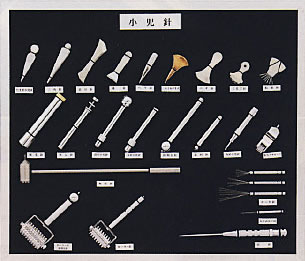A Brief History of Japanese Acupuncture
Yasuyori Tamba, an acupuncture doctor, who served at a court presented Ishinpo, the oldest medical book existing in Japan, to the Emperor in 984. This book contains a systematic compilation of information on various medical practices: acupuncture, moxabustion, herbs, diet, pediatric treatment, etc.
It was not until the Nara Period (700-788 C.E.) that the first medical system was established in Japan. Acupuncture and moxabustion therapy became the national medicine. During the Kamakura and Muromachi Periods (1189-1572 C.E.), many monks learned acumoxa therapy. These methods spread along with the acculturation of Buddhism.
Waichi Sugiyama (1610-1694) devised the guide tube method (the method of placing a needle inside a tube and then tapping it into the skin). The needle tube makes it possible to insert a thinner needle. Sugiyama also revitalized the concept of root treatment (honchiho) and branch treatment (hyochiho).

In the Azuchi (1568-1600 C.E.) and Edo (1600-1868 C.E.) Periods, acupuncture and moxibustion became distinctly Japanese, developing characteristic Japanese features. Isai Misono (1557-1616) realized that thin needles made of gold and silver were better suited for Japanese people than regular steel needles. He advocated the use of gold and silver needles and the use of a wooden hammer to tap the needle for gradual entry into the skin.
During this era, Western medicine introduced by Dutch seafarers was also used. Meanwhile, in China, the government rejected European entry. As a result, Japanese-style acupuncture and moxibustion became more familiar in Europe. A priest who came to Japan to introduce Christianity reported, “The Japanese people, due to the weather and food of the land, are generally healthy. When they become sick, they stick silver needles into their arms, stomach, and back for any kind of pain.” However, acupuncture therapy was available only to the Emperor and other wealthy people. The common people sought relief with herbal medicine, amma massage, and moxibustion, techniques handed down through family traditions.
In the Meiji Period (1868-1912) the government-backed Western biomedicine as it proved to be valuable for the military. The government established a law stating, “Only those who studied Western medicine are recognized as doctors.” At this point, traditional medicine went into decline. It might have vanished completely had not a doctor by the name of Keijyuryo Wada wrote Caution in the Medical World in Meiji 43 (1910), wherein he explained the superiority of Chinese traditional medicine and warned the medical world about the danger of resorting to only Western biomedicine.
Many doctors were influenced by this article and consequently studied traditional medicine since most of them were clinicians who dealt with patients on a daily basis. They recognized the excellence of traditional medicine as a therapeutic tool.
During the Showa Era (1927-1989) a therapeutic system gradually developed, and with skill refinement and in-depth study, acumoxa therapy held its ground as a traditional medicine in Japan, even though Western medicine still had a strong influence.
In the same way that the Shang Han Lùn (On Cold Damage) assigns a “sho” (pattern) to a person’s condition and prescribes medicine accordingly, the concept of “sho” was introduced to acumoxa therapy. Thus a systematic approach to diagnosis and treatment was devised. It came to be known as Keiraku Chiryo (Channel Therapy). It mainly expressed sho in terms of the repletion and vacuity of the twelve meridians as determined by six-position pulse diagnosis. The five-phase points of the limbs were used to restore balance.
History from Acupuncture Core Therapy, Shakujyu Chiryo Shoji Kobayashi, Paradigm Publication 2008 used with permission.